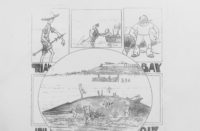The German wagon – A Cultural Icon
The German Wagon is still today seen as the cultural icon of the German-Queensland farming culture and until the last decade were to be found in abundance – in varying states of decay – throughout the farmlands of southern Queensland. Many of these cultural reminders have gained in value and have become expensive garden ornaments as the growing urban populations of southeast Queensland try to impress their neighbours and community with ‘folksy’ farm artifacts displayed on manicured lawns. In fact, because of their antique value, it is now rare to find wagons in their ‘native habitat.’ Museums throughout southern Queensland and private farm machinery collectors today possess the last obvious vestiges of the once extensive culture.
Crafted by many of the German blacksmiths in rural Queensland, the wagons were based around a similar design, with minor variations. The basic prototype was brought out with the pioneers from northern Europe. Blacksmiths who made large numbers of wagons were many- including Gottlieb Schneider (Beenleigh), Benno Schuster (Tallebudgera), the Weimers family (Toowoomba), the Qualischefski clan of blacksmiths (Lockyer Valley).
A few Stories…..
‘There was a time Grossvatter Keune had a wagon which had a pole where you put a horse on each side. There weren’t too many wagons among the settlers and his wagon was used by people to take the produce to town. On this one occasion this one particular family liked to, after they had sold their produce and bought their groceries, spend a little bit longer at the Hotel and they came home in the dark and jogging along the road and having a few light ales, makes one sleepy. So they anchored themselves against the side of the wagon and let the horses take them home. When they came out to Watchbox Road the horses turned rather sharp and the wagon wheel hit the corner post of the fence and with the jolt that was received the pole was broken. This farmer reported back that the pole got broken last night and that he would take the wagon back to the Blacksmith at Goomeri to have the pole re-inserted. A week later information came that the wagon was ready for collection, so the farmer kindly offered to go and fetch it and deliver it to Tansey. Again the lure of the light ale took hold and on the way back exactly the same accident happened. Offering to take the wagon back again to Goomeri for repair was this time refused. My grandfather said “NO this time I’m going to bring it back”. So he got his wagon home in one piece!’
(from the late Les Keune, Goomeri)
Local Toowoomba author Colin Beutel recalls his dangerous encounter with a German wagon in the incident below, which took place in the German settled Ravensbourne district: ‘At the age of about three years I was quietly looking through the boards of the German wagon on Herman Wackerling’s farm, after the corn crop had been pulled and thrashed.…. When suddenly the two draft horses bolted. I remember hanging on for grim death to the right side of the wagon.… away they galloped, with me hanging on grimly to the right side of the wagon, which was swerving crazily from one side to the other. My brothers realizing what had happened dropped their loads and headed the horses into a fence. … We all arrived home safely that evening at our Ravensbourne home.’
Pre-Automobile Contests
Young (and not-so-young) men have always seen the ‘need for speed’ – even in the days before the automobile era. German wagon ‘races’ were a fairly common event – particularly among the young bucks of German districts in southern Queensland. The sturdiness and well built German wagons were akin to chariots and a race of such vehicles was really something to observe, making sure you were not in the path of the contestants. In a much repeated tale, August Kratzke of Highfields is accredited with the driving of such a wagon at breakneck speeds after an afternoon ‘session’ at Toowoomba pubs in the 1890s. As he drove his wagon cross country back to his home property at Highfields, at one stage women and children picking potatoes were forced to flee from the oncoming chariot which was traveling at an incredible speed! In another documented instance in the Lockyer Valley some of the young bucks would abscond from religious observances much earlier than the end of the Sermon and would race and thunder up and down nearby roads until apprehended by the older members of the congregation.



